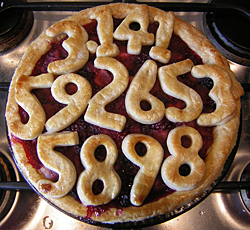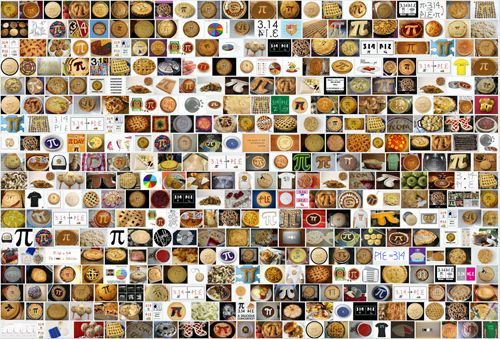Serving up Some Pi Pie for Pi Day
March 14 is Pi Day, so grab a slice, and your best memorization skills. How much Pi can you remember—which is not quite the same as how much pie can you eat!

Celebrating Pi Day with Pie
A Google search or a Pi-focused look at Pinterest turns up all kinds of great Pi pie. The pie above, with the opening numbers of Pi cookie-cut and used as the top crust is a wonderful tribute to Pi! Image: Kat M.
No matter how you slice it, you can use pie to observe Pi in action, which makes things handy when it comes to dishing up some tasty math. Speaking of pie, if you know the formula for finding the area of a circle, then you will understand this math joke "Pies are not square, they are round." (Confused? The formula for determining the area of a circle is A = πr2. Read it out loud to "hear" how it sounds. Then entertain your kids in class, in the car, or at dinner with your pithy math humor.)
Celebrating Pi
Today is Pi Day, and when I went looking to see what I said last year about Pi Day and the interminable decimal places of venerable Pi, the sequence that both enthralls and haunts many mathematicians, I discovered that no blog post exists at Science Buddies on Pi. 3.14159 what?
How can this be? I know the Golden Ratio has come up. I know Fibonacci has made an appearance. I know I've regaled the virtues of histograms and data collection and even the sorting and counting of M&Ms—for fun or for an exploration of survival and camouflage. I've shared a tale of a few hundred straws, hexagons, and a geodesic dome that almost didn't fit through the door. But no coverage of Pi Day?
It is completely irrational.
As is Pi!
For mathematicians, Pi Day is a day to pay homage to a serious number, a number that isn't really all that big when you think about the fact that 3 is smaller than 4. But Pi is a number that stands the test of time and a number that mathematicians have spent countless hours studying, memorizing, computing, and exploring. Like the Golden Ratio, Pi is an irrational number, a number that cannot be expressed as a simple fraction, a numbers whose decimal place digits continue endlessly without repeating. (According to the Mathisfun website, "People have calculated Pi to over a quadrillion decimal places and still there is no pattern.") Want to take a look at the first million digits? You can see them on the Pi Day site.
So how many digits of Pi do you know? We shorten Pi, all the time, to 3.14. When we multiply something by Pi (like r2 when solving for the area of a circle), we multiply by 3.14. But, really, with more than a quadrillion decimal places known, there is a whole lot more to Pi than just 3.14! There are competitions even to see how many digits of Pi people can recite. The Guinness World Records holder set the current record in 2005 by reciting 67,890 digits of Pi, a verbal feat that took more than 24 hours.
Making Connections
What's the longest number you know? A 9-digital identification number? A 10-digit phone number? A 16-digit credit card number? What's the max number of digits you can commit to memory and why?
Memorizing Pi to thousands of places doesn't necessarily have a purpose, but it is an interesting test of memorization technique and skill. Students can explore variables that may influence numeric recall in the How Many Numbers Can You Remember? project. This project can be great for an independent student project, fun as a class activity, or just good for family dinner conversation. You can use any numbers in the project, including randomly generated number strings, but this is a great experiment to do with the digits of Pi—even while eating pie on Pi Day!
If memorizing more than a few digits of Pi seems complicated to you, what happens if you explore the use of mnemonic devices? We often think of mnemonic devices as a way to help remember items in a sequence (like the planets) or a list of things, but people do come up with mnemonic devices to help with the recall of number strings, too.
To find out more about mnemonic devices and to put a few to the test, see the full Memory Mnemonics science project or check out our family-friendly activity version, part of Scientific American's Bring Science Home.
Have a great Pi Day 2014, and if there is pie, let it be circular and sweet.

More Family and Classroom Math
For suggestions on ways to integrate math into your everyday classroom or family activities, see Making Room for Math.
Categories:
You Might Also Enjoy These Related Posts:
- 15 STEM Gifts & Science Kits You'll Feel Good About Giving
- 13 Boat Science and Submarine Science Projects and Experiments
- July 4th STEM! Summer Science Picks for Independence Day!
- 12 Science Kits for Summer Science Experiments and Discovery
- 15 Science Projects to Make and Give for Father's Day
- Ready, Set, Go! (Awesome Summer Science Experiments)
- Awesome Summer Science Experiments
- 10 STEM Activities with Cardboard Tubes









